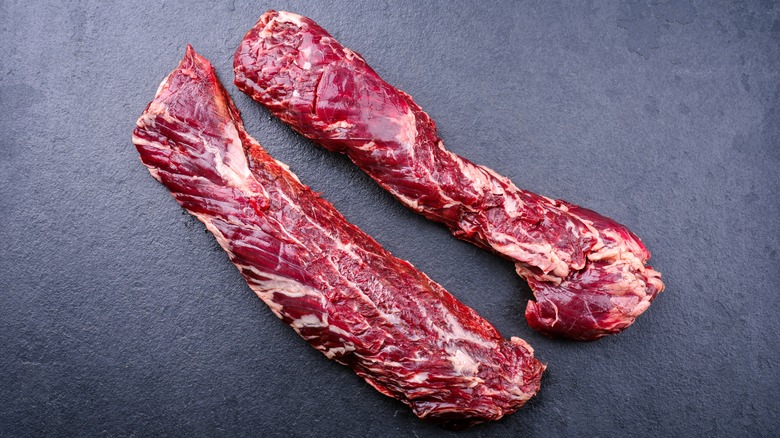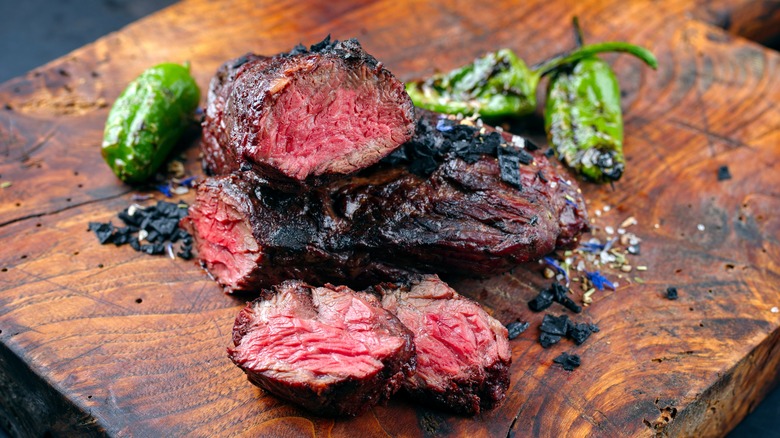The Steak Cut Anthony Bourdain Thought Was Totally Underrated
We may receive a commission on purchases made from links.
Anthony Bourdain made a career of opening eyes. Whether that was through searingly honest exposés of the culinary world's innards, or traveling the world and showing off the greatest cuisines you've never heard of, he spent his life committed to showing us something new. That applied to something as simple as choosing the best cut of steak, too. Though Bourdain's favorite was a rib cut, he wrote of another totally underrated, supremely tasty, remarkably affordable cut of meat: The onglet, or the hanger steak.
Perhaps this steak's status as an underdog is why Bourdain loved it. Hanger steak is something of a black sheep at the butcher's counter. Though the French have long praised it, it remains underappreciated in America. The steak is also known as the butcher's tenderloin in the U.S., but not because it was particularly prized by butchers — customers just didn't want it, so inevitably it ended up getting taken home at the end of the day. The onglet isn't particularly attractive, far from pretty-in-pink filets or plump ribeyes. It's narrow, fibrous, and dark in both flavor and appearance.
However, Bourdain wrote in The New York Times that he "was immediately struck by its ropy, not-too-tender but not-too-tough texture and its strong, almost kidneyish flavor." When prepared properly, the onglet is indeed delicious. It's taken from the diaphragm of the cow, so when the animal is butchered, it's exposed to air right away. That early exposure leads to more oxidation, and therefore a darker, heartier flavor.
How Anthony Bourdain liked to cook onglet
In the same New York Times column, Bourdain calls his first experience with onglet "Strange, exciting, even a little scary." It's a relatable feeling for anyone venturing beyond more popular cuts of steak, but with unfamiliarity comes uncertainty when preparing it. Fortunately for us, Bourdain had some useful musings. As he was prone to do, he reached for old French techniques –- and the French do indeed know best here.
Onglet is a thrifty steak, and according to Bourdain, it should be treated accordingly, making the most of what is available and served unpretentiously. In the region of Bordeaux, he writes, onglet is served "en sarment" — grilled over dried grapevines. For the famous wine-producing area, this makes perfect sense and infuses the meat with a bold, smokey fruitiness that naturally complements the more bombastic, muscular notes of the beef. One of Bourdain's recipes in his "Les Halles Cookbook" leans on similar flavors in a salade d'onglet, pairing the steak with a tart red wine vinaigrette and fresh greens for a wonderfully balanced dish.
How to cook it at home, and where to buy it
While you may not be able to cook your steak over dried grapevines, you can still prepare a beautiful onglet at home. Begin with a quick but thorough sear over high heat. Pull it off the heat after about two to three minutes on each side. Once you've rested your steak, a step Bourdain considered the most crucial in the entire cooking process, slice it against the grain and serve. The French like to serve onglet with peppercorns as part of a classic steak frites, a dish Bourdain famously served at his Les Halles restaurant in New York, but hanger will go nicely with a long list of sauces to boost your steak meal. Chimichurri is your friend here; its bright herbiness contrasts with the gamey hue of the meat and the kiss of char from the crust.
You'll be able to buy this cut at pretty much any butcher counter – just go and ask for a hanger steak (if you're in the U.S.) or an onglet. If you feel like saving yourself the knife work, you can ask your butcher to trim the steak for you. You might also be able to buy onglets frozen or freeze them yourself for later. If you do, make sure you use them within a month and defrost the meat slowly, preferably overnight.



